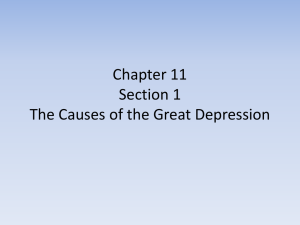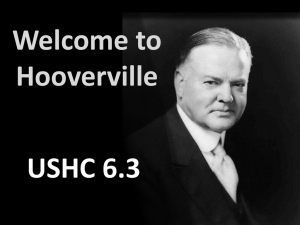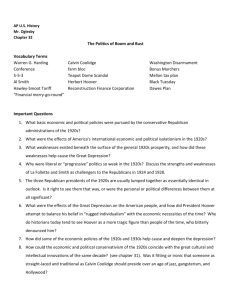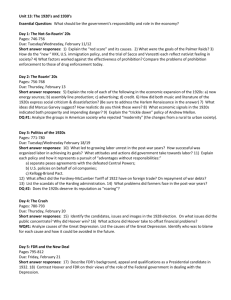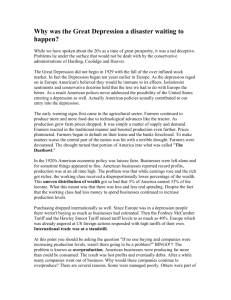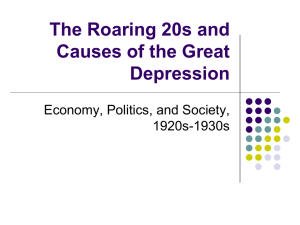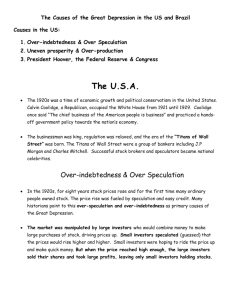File
advertisement
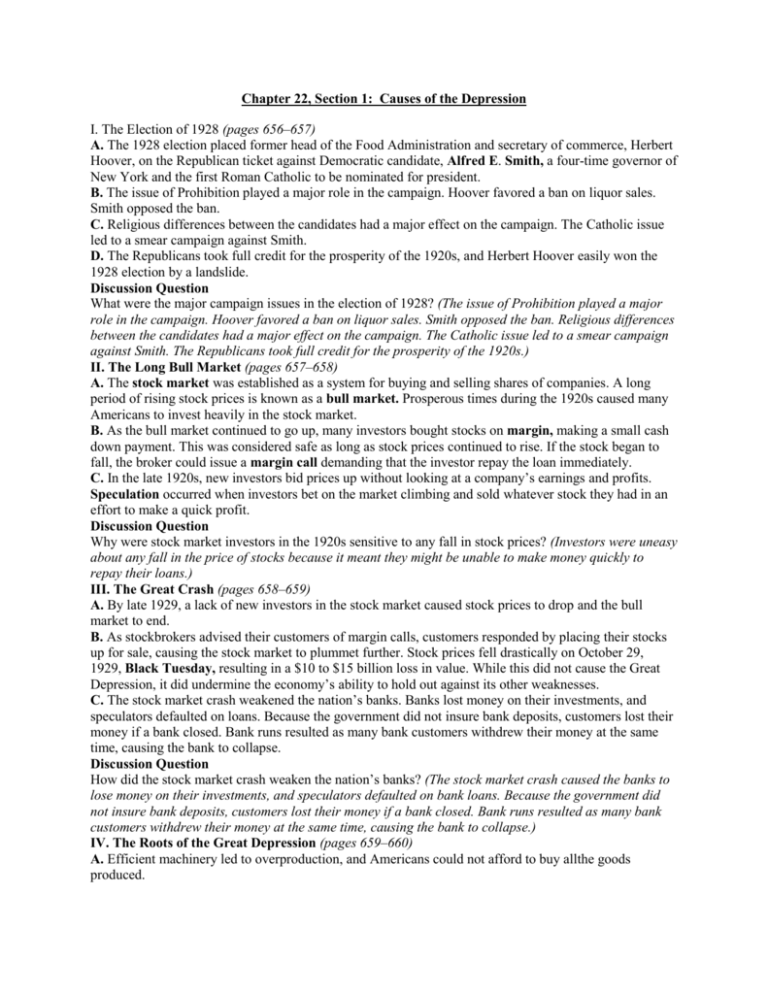
Chapter 22, Section 1: Causes of the Depression I. The Election of 1928 (pages 656–657) A. The 1928 election placed former head of the Food Administration and secretary of commerce, Herbert Hoover, on the Republican ticket against Democratic candidate, Alfred E. Smith, a four-time governor of New York and the first Roman Catholic to be nominated for president. B. The issue of Prohibition played a major role in the campaign. Hoover favored a ban on liquor sales. Smith opposed the ban. C. Religious differences between the candidates had a major effect on the campaign. The Catholic issue led to a smear campaign against Smith. D. The Republicans took full credit for the prosperity of the 1920s, and Herbert Hoover easily won the 1928 election by a landslide. Discussion Question What were the major campaign issues in the election of 1928? (The issue of Prohibition played a major role in the campaign. Hoover favored a ban on liquor sales. Smith opposed the ban. Religious differences between the candidates had a major effect on the campaign. The Catholic issue led to a smear campaign against Smith. The Republicans took full credit for the prosperity of the 1920s.) II. The Long Bull Market (pages 657–658) A. The stock market was established as a system for buying and selling shares of companies. A long period of rising stock prices is known as a bull market. Prosperous times during the 1920s caused many Americans to invest heavily in the stock market. B. As the bull market continued to go up, many investors bought stocks on margin, making a small cash down payment. This was considered safe as long as stock prices continued to rise. If the stock began to fall, the broker could issue a margin call demanding that the investor repay the loan immediately. C. In the late 1920s, new investors bid prices up without looking at a company’s earnings and profits. Speculation occurred when investors bet on the market climbing and sold whatever stock they had in an effort to make a quick profit. Discussion Question Why were stock market investors in the 1920s sensitive to any fall in stock prices? (Investors were uneasy about any fall in the price of stocks because it meant they might be unable to make money quickly to repay their loans.) III. The Great Crash (pages 658–659) A. By late 1929, a lack of new investors in the stock market caused stock prices to drop and the bull market to end. B. As stockbrokers advised their customers of margin calls, customers responded by placing their stocks up for sale, causing the stock market to plummet further. Stock prices fell drastically on October 29, 1929, Black Tuesday, resulting in a $10 to $15 billion loss in value. While this did not cause the Great Depression, it did undermine the economy’s ability to hold out against its other weaknesses. C. The stock market crash weakened the nation’s banks. Banks lost money on their investments, and speculators defaulted on loans. Because the government did not insure bank deposits, customers lost their money if a bank closed. Bank runs resulted as many bank customers withdrew their money at the same time, causing the bank to collapse. Discussion Question How did the stock market crash weaken the nation’s banks? (The stock market crash caused the banks to lose money on their investments, and speculators defaulted on bank loans. Because the government did not insure bank deposits, customers lost their money if a bank closed. Bank runs resulted as many bank customers withdrew their money at the same time, causing the bank to collapse.) IV. The Roots of the Great Depression (pages 659–660) A. Efficient machinery led to overproduction, and Americans could not afford to buy allthe goods produced. B. The uneven distribution of wealth in the United States added to the country’s economic problems. In 1929 the top 5 percent of American households earned 30 percent of the country’s income. More than two-thirds of the nation’s families earned less than $2,500 a year. C. Low consumption added to the economic problems. Worker’s wages did not increase fast enough to keep up with the quick production of goods. As sales decreased, workers were laid off, resulting in a chain reaction that further hurt the economy. D. Many Americans bought on the installment plan, making a down payment and paying the rest in monthly installments. Paying off installment debts left little money to purchase other goods. E. The Hawley-Smoot Tariff intensified the Depression by raising the tax on imports. Americans purchased less from abroad because of the high cost. In return, foreign countries raised their tariffs on American products, causing fewer to be sold overseas. F. Instead of raising interest rates to stop speculation, the Federal Reserve Board made the mistake of lowering the rates. This encouraged banks to make risky loans and misled business owners into thinking the economy was still expanding. Discussion Question How did the Federal Reserve Board help cause the Depression? (Lowering the interest rate instead of raising it helped cause the Depression in two ways. First, it encouraged banks to make risky loans. Second, it made it appear as if the economy was still thriving, which caused businesses to borrow money to further expand their production.)
